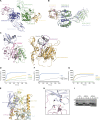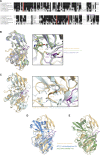The structural basis for deubiquitination by the fingerless USP-type effector TssM
- PMID: 38170641
- PMCID: PMC10719079
- DOI: 10.26508/lsa.202302422
The structural basis for deubiquitination by the fingerless USP-type effector TssM
Abstract
Intracellular bacteria are threatened by ubiquitin-mediated autophagy, whenever the bacterial surface or enclosing membrane structures become targets of host ubiquitin ligases. As a countermeasure, many intracellular pathogens encode deubiquitinase (DUB) effectors to keep their surfaces free of ubiquitin. Most bacterial DUBs belong to the OTU or CE-clan families. The betaproteobacteria Burkholderia pseudomallei and Burkholderia mallei, causative agents of melioidosis and glanders, respectively, encode the TssM effector, the only known bacterial DUB belonging to the USP class. TssM is much shorter than typical eukaryotic USP enzymes and lacks the canonical ubiquitin-recognition region. By solving the crystal structures of isolated TssM and its complex with ubiquitin, we found that TssM lacks the entire "Fingers" subdomain of the USP fold. Instead, the TssM family has evolved the functionally analog "Littlefinger" loop, which is located towards the end of the USP domain and recognizes different ubiquitin interfaces than those used by USPs. The structures revealed the presence of an N-terminal immunoglobulin-fold domain, which is able to form a strand-exchange dimer and might mediate TssM localization to the bacterial surface.
© 2023 Hermanns et al.
Conflict of interest statement
The authors declare that they have no conflict of interest.
Figures








References
-
- Adams PD, Afonine PV, Bunkóczi G, Chen VB, Davis IW, Echols N, Headd JJ, Hung LW, Kapral GJ, Grosse-Kunstleve RW, et al. (2010) PHENIX: A comprehensive python-based system for macromolecular structure solution. Acta Crystallogr D Biol Crystallogr 66: 213–221. 10.1107/S0907444909052925 - DOI - PMC - PubMed
Publication types
MeSH terms
Substances
Associated data
- Actions
- Actions
- Actions
- Actions
- Actions
- Actions
- Actions
- Actions
- Actions
LinkOut - more resources
Full Text Sources
Research Materials
